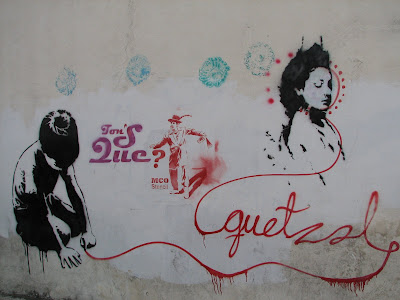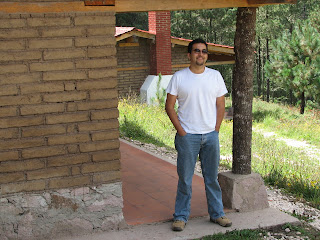Which leads me to think that whoever tags FUERA URO for the thousandth time is another young kid who sees little to lose even if he gets caught, which is unlikely given the ten seconds it takes to spray 8 letters on a wall in quasi-cursive. Not to say that I think such a sentiment doesn't deserve expression, but there's clearly a more effective and creative way to say so.
Usually such guerrilla expression is painted over as quickly as it's portrayed, if not in quite the same color the wall might have been originally painted. Case in point, underneath and below the man in red are some tan squares that doubtlessly cover over some less inspired creativity, while the gentleman wheat-pasted on the wall is still there as I write today, if in a slightly more tattered state. Whoever painted over in tan what was painted before deemed this portrait fit to remain. Is it because this fellow is more visually appealing than one more tagline on the wall, or because, having been created on paper, he's bound to come down on his own before long anyway?
If that's true, wheat-paste art, for its impermanence, might be the way to make a point last a little longer. Existing on paper, it also has the advantage of being infinitely reproduceable, as was the case with this anti-bullfighting propaganda that caught my eye my first week here this year:
The medium of guerilla expression I appreciate the most, I think, shares with wheat pasting the benefit of being infinitely repeatable, and in the case of the simpler versions, quick to be put on the wall. It also retains the classic element that made graffiti the art form that it's become: the spray bottle. Of course, I'm referring to stencil art.
Okay, so this one goes beyond simple stenciling, and it probably didn't go up in just a few seconds, either. But it does illustrate why stencil lends itself to some highly creative expression. It blends nicely with more traditional spray can graff, and while it can be as simple as a single tone outline, it can clearly be taken much further. Work like this also raises the question: when does art borne in the street become something besides what the word graffiti brings to mind? Does this art - here in Oaxaca or elsewhere - have a place outside of city walls?
As I walked to Ollin one day, I saw on the wall of a bus stop a sight that brought my rhetorical question closer to a real answer:

This poster, along with a half dozen or so others, was promoting a gallery opening of a project by various students at Bellas Artes, a fine art school across the plaza from the chapel of La Soledad. Appropriately enough, this exhibit, displaying a collection of work sprung forth from the movement of resistance that arose in this city over the course of several months in 2006, was promoted by means of flyers wheat-pasted around town. I had the fortune of being able to attend the art opening, and happened to choose a route to the gallery that put me in a better frame of mind to appreciate the medium:

This brooding scene appears amidst a downtown neighborhood given over to the cause of guerrilla expression ranging from the simplest scrawled message to vistas such as this one. Connecting the dots even further were the halls of Bellas Artes themselves, graced as they were by the presence of some well-rendered zoology.
At which point I arrived at the entrance to the gallery, in time to join in the audience of the commencement of the exhibit, given by a number of faculty at Bellas Artes, and distinct from other gallery openings I've attended by virtue of a ribbon cutting ceremony. An auspicious introduction to a project inspired by a movement borne in the streets. While I spared the presenters my flash during their introduction, I was shameless in photographing the work on display after the initial rush of onlookers had subsided.

This piece, for me representative of the collection for its imagery - elements of which I've seen in street art both this year and last - as well as its statement of popular solidarity, brings together symbology given definition in our minds throughout the history of the culture of modern urban uprisings. The most central image in this work could be found around the city during this year's guelaguetza, a traditional Oaxacan summer fiesta tradition this year punctuated by a brief relapse of conflict between protestors and police:
Such an image, removed promptly from the canvas of the public streets after the guelaguetza was over, is now reappropriated and raised up on exhibition at the city's well-known school of fine art, where it joins a well-articulated assembly of modern visual archetypes, some distinctly Mexican, others universal. The street corner above, like many others in town, is home to ancient walls weathered by many generations of paint and paste. Like the countless doors one passes in the streets, they offer a glimpse inside the city's hidden corridors.




























